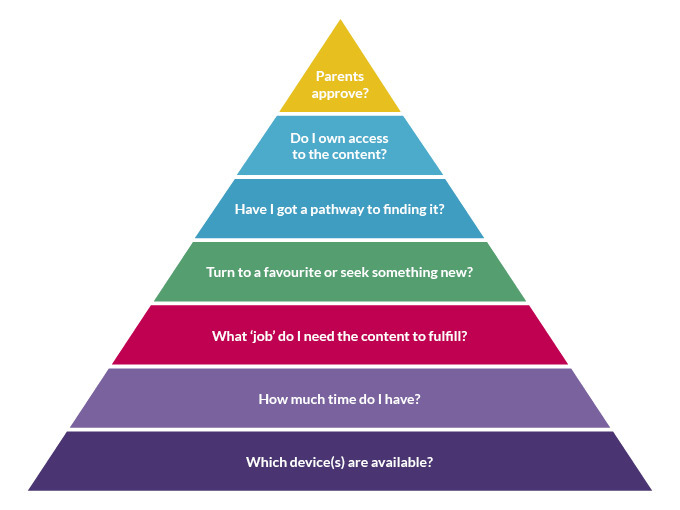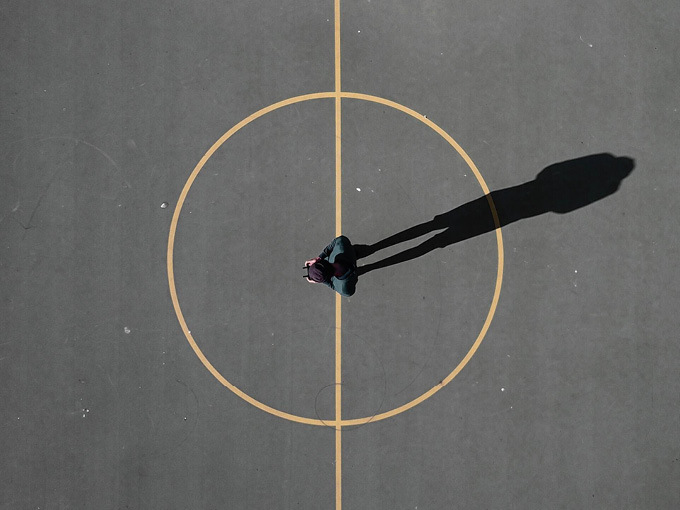At Dubit, we often talk about how “everything competes with everything” in the current children’s media world. Kids don’t think, “Do I watch this video or that one,” or consider what game to dive into next. Instead, they choose among all their option—device, platform and content—based on a Maslow-ish hierarchy of factors. (You can see our take on Maslow’s hierarchy below.)
But if everything competes, then everything also connects. The choices kids make reflect an understanding that technologies and applications each play unique roles and provide distinct gratifications. And for that reason, young people often combine several to create a complete and coherent immersion in their favorite brands and content.

Perhaps the best example is what Dubit calls the “gaming circle.”
Imagine nine-year-old Jamie—he’s just gotten into Fortnite because it’s what his friends on the playground talk about. After school, he joins them in Battle Royale, but as a noob, he’s not getting very far.
When he sets down the game, Jamie heads to WhatsApp to ask his friends how to get better. They send him YouTube links to the newest how-to videos with strategic advice and hacks. Jamie streams the videos on the family’s smart TV to make sure he doesn’t miss anything.
Armed with new skills, Jamie goes back to the game. As he improves, he starts to dream of becoming competitive. So when he’s not playing the game, he’s one of Jelty‘s 2.2 million faithful followers on Twitch, all while wearing Jelty’s G2 Atlantis team shirt (merch is a platform, too). What he sees there deepens his passion for playing, so he’s right back into the game.
Jamie doesn’t have much use for Twitter, and he’s pretty young for Reddit, but he follows Fortnite accounts and threads on both to find out when seasons start and finish, monitor what new accessories and weapons are coming, and hear about special events like concerts that are taking place on the platform.
Jamie’s older sister Emma started building in Minecraft when she was his age, and now at 14, she’s very accomplished. She learned a lot by reading Minecraft books and watching YouTube videos. As soon as she turned 13, her parents allowed her to get her own channel, where she shares her latest builds along with tips and tricks for mining and crafting. Her Instagram account is filled with images of her work, including a Minecraft model of her junior high that she built so the school could host a virtual graduation during COVID.
Emma launched a Discord channel with Minecraft friends from all over the world, where they build on a shared server while chatting about everything from the game, to homework, to annoying little brothers.
Like many fans, Jamie and Emma discovered the games first, then pursued other ways to feed their engagement. Other fans might have seen a video or other expression of a game first, leading them to become players. Because it’s all a circle, it eventually returns to the game.
Not every IP is a game, but kids connect with content in much the same way. A TV fan probably watches on linear, follows on social, reads the books, buys the gear, and more. But they might have been exposed to the book or the merch first, leading them back into the TV show. The circle exists, because everything competes and everything connects.
Whatever platform producers choose to begin drawing their circle, they need to ask themselves what the plan is for building engagement and sharing as a young person’s passion for their content deepens? You don’t need to “loop in” every single platform or touchpoint; in fact, it’s easy to spread your brand too thin and lose impact. But it’s important to remember that everything inevitably connects, and so simplicity in navigating the brand’s “circle” is crucial; otherwise audiences may hit a dead end.
Photo by Luís Eusébio on Unsplash























